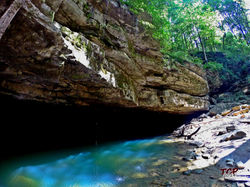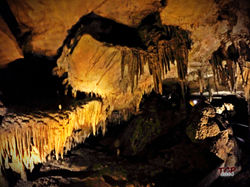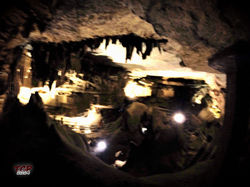
Mammoth Cave. America's most haunted national park.
The Mammoth Cave National Park in Kentucky, USA boasts the worlds largest explored cave system.
It is a limestone cave system with known passages of over 550 kilometers; it is the most massive and varied cave ecosystem on Earth; it is a UNESCO International Biosphere Reserve; it is a UN World Heritage Site recognized for international preservational importance; it is known as the most haunted national park in the US. From a former slave, to early cave guides, and even the found-dead that were staged in the "Haunted Chamber" and purchased by anatomists for parading all over the country... the list of hauntings here is long indeed.
It is said the ghost of Stephen Bishop, a slave turned cave-explorer, path-clearer, stone-cabin-builder, likes to hang out in the tour gallery. He is seen slightly behind everyone else in period clothing, particularly during the "Violet City Lantern Tour". While I did not partake in that tour, I did have the pleasure of experiencing the other lantern-only tour, the "Star Chamber Tour". I was wanting the authentic experience, but I wanted it at night. While I am sure the isolation of the cave would have provided the "feel" of nighttime at 1:15 in the afternoon, my brain needed the atmosphere that could only be offered by the last tour to leave on any given day, the 6:15pm-9pm Star Chamber Tour. Unfortunately the very nature of this experience made photography impractical. Though I flirted with the idea of bringing an IR cam, black and white wouldn't show much depth, and cave dust would've shown an underground Orb-City. (Full disclosure: TCP in no way endorses "orb" activity as evidence of any kind. It will take a full-bodied apparition spelling out "Hey, idiots, I'm right in front of you" with color changing, neon orb drawings visible to the naked eye for us to change this view.) I ultimately decided that going in blind, and writing about it later was the way to go for this subterranean experience.
Led through the darkness only by lantern light, we are guided to a large expanse with a ceiling of jet-black. The gypsum in the cave system is easily colored by soot from candles and lanterns, and after 200+ years of touring and exploring, this particular room shows full effect. It is here your eyes play tricks on your brain, and it was here that famous poet Ralph Waldo Emerson rested after a long exploration with some friends, his story "Illusions" is based on this trip, even calling it out directly. As the poet put out his oil lantern, the chamber was so black that his eyes gazed only the light that once was there, seemingly flickering like stars fading slowly out of view. This is the latest tour offered on any given day, it is by lantern only, and it truly feels like the cave itself stares right through you. It wouldn't have surprised me in the least to see Stephen Bishop at any point during my journey through the darkness. There is an ominous prescence here that is impossible to ignore. You can feel it around every corner, and with every step, almost dancing in your peripheral vision, daring you to find it. Sitting in the Star Chamber you come face to face with your very consciousness as the guides collect all of the lanterns and take them away to a hidden path to the right, reappearing 5 minutes or so from the left. Recreating the conditions that Ralph Waldo Emerson would have experienced was simultaneously maddening and beautiful, there is no better way to be alone with your thoughts than in a silent black hole. Our group breaks the silence at the guides request by making forest animal noises as the "daylight rises" from the left, my only remaining question is: Why do so many people think cows live in the forest?
The path to the Star Chamber is by waypoint of the "Consumptive Cabins", 2 remaining structures used to house Tuberculosis patients in 1839. Dr. John Croghan started this ill-fated experiment, believing that the cave air may be a cure for the epidemic of the time. He invited 15 patients to participate, and when they contiued dying anyway the trial was deemed a failure and the few survivors were sent home. Dr. Croghan ironically contracted tuberculosis himself, and it claimed his life in 1849. It is in this area, if you listen closely, you may hear phantom coughing from the patients awaiting their doom from a respiratory disease made worse by the cool damp air. Sure enough as I peek into the first structure I am greeted by the faint sound of a hard cough which seems to have originated from the front left corner inside. What else can be expected in a cave system quiet enough to hear your own heart beating like a pounding drum in the stillness? I am convinced that any visitor to this area will be able to hear this coughing, provided they listen for it.
Bodies discovered in the cave are plentiful and include (though not a comprehensive list): prehistoric settlers, early explorers, saltpeter miners, consumption casualties, and lost travelers. All of these cadavers share something in common, they tend to stick around. The unique temperatures, pressures, and humidity levels in the cave provide ideal conditions for limiting decompisition and, dare I say it, mummification. I dare say, 7 of them to be exact, the last one found in 1935 named "Lost John". It is on a rock shelf of sorts near the entrance to the appropriately named "Haunted Chamber" where left behind bodies were placed during the clearing of the show cave. It is here that traveling doctors and anatomists would bid on the immaculate cadavers for use in their promotions. If an anatomist rolled his wagon into town promoting the latest elixer he may draw a small crowd. If he brings with him a 3,500 year old body, however, he will draw a whole city. Even Lost John was paraded around until 1976, when federal law otlawed the display of Indian remains. Passing the cadaver display shelf enters a narrow cave, with an even smaller path continuing onward. The sides of the path in this area are lined with stacked stones which stand effigy to those found dead in the caves, creating an eerie almost tunnel-like trail. Staying the path rewards you with a view of the end... a wedding chapel. You read that correctly, passing a corpse display case, and a narrow graveyard, leads to a place of holy matrimony. I'll let you insert your own joke for this one, but for those with a taste for the macabre, this was quite the place to tie the knot until the formation of the national park officially outlawed it.
As far as haunted tours go, this was VERY unique. There are no shadows in the pitch black, and no one hears you screaming at 9,000 feet below the Earth. I would recommend this location and the Star Chamber Tour to anyone in the mood for a one of a kind spooky experience. The Violet City Lantern Tour covers this one and a little bonus, ancient petroglyphs on the cave walls. Next time I'll be sure to check it out, but you truly cannot go wrong either way. The lantern tour wasn't the only reason for our trip, check out the gallery below to see some views we had in the daylight. Enjoy the gallery, and until we meet again, Stay Spooky!
 River Styx Spring .One of a handful of natural "Blue Hole" phenomena, the energy here is nothing short of incredible. The spring rests like a colorful mirage from the observation boardwalk. |  The River Styx Trail Spring.Originating from the cave system itself, this spring feeds into the Green River that is perpetually carving out more of the cave. Up close and personal, because boundaries are for sillynannies. |  Lost River Cave. The Blue Hole.One of four blue holes in the Lost River Cave system. Also called "karst windows" the submerged cave appears blue due to light reflecting off of water with high limestone content. |
|---|---|---|
 Lost River Cave. The Reception Hall.You can entertain a wedding party next to one of the largest cave entrances east of the Mississippi River, or maybe just enjoy a stroll on the only underground cave boat tour in Kentucky. |  Frozen Niagara.There are surprisingly few cave formations in the Mammoth Cave system, owing mostly to geological influences during its formation. |  Domes and Dripstones.Along the path on the Domes and Dripstones tour you will notice massive boulders left in the wake of the cave formation. |
 Domes and Dripstones Break.The National Park Rangers are informative and witty, and they have the perfect ambient surroundings to employ their craft on the audience, |  Mammoth Cave.While the addition of electric light makes for breathtaking views in the cave, it also has lead to the growth of algae, mosses and fungi. Preservation here is difficult, as Mammoth Cave is not a closed cave system. |  Niagara Expanse.Showing off is what this cave does best. If you want to see all your tour has to offer, your head should be on a swivel. |
 Stalactites.These stalactite formations resemble a fragile wall of bacon, so park staff refer to it as such. They don't get cute with nomenclature here. |  Cave Formations.A dramatic cave formation toward the end of the Frozen Niagara area. |  Farewell.A farewell to a wonderful host. |
